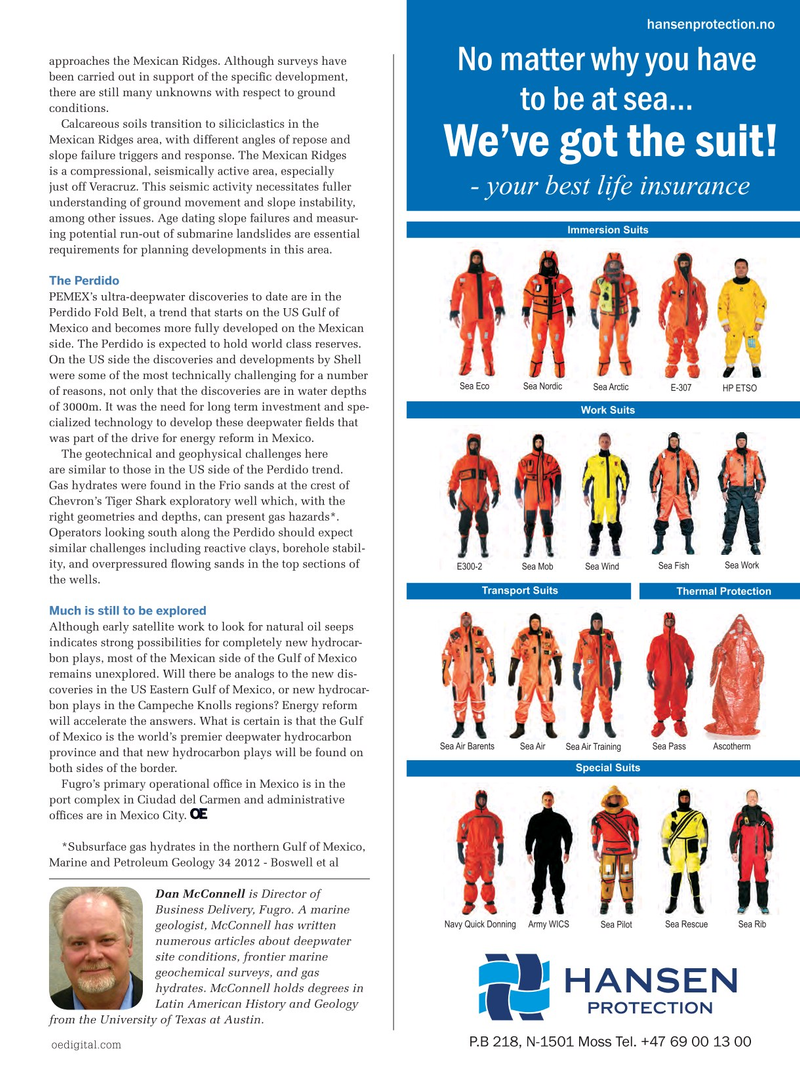
Page 31: of Offshore Engineer Magazine (Mar/Apr 2015)
Read this page in Pdf, Flash or Html5 edition of Mar/Apr 2015 Offshore Engineer Magazine
approaches the Mexican Ridges. Although surveys have been carried out in support of the specifc development, there are still many unknowns with respect to ground conditions.
Calcareous soils transition to siliciclastics in the
Mexican Ridges area, with different angles of repose and slope failure triggers and response. The Mexican Ridges is a compressional, seismically active area, especially just off Veracruz. This seismic activity necessitates fuller understanding of ground movement and slope instability, among other issues. Age dating slope failures and measur- ing potential run-out of submarine landslides are essential requirements for planning developments in this area.
The Perdido
PEMEX’s ultra-deepwater discoveries to date are in the
Perdido Fold Belt, a trend that starts on the US Gulf of
Mexico and becomes more fully developed on the Mexican side. The Perdido is expected to hold world class reserves.
On the US side the discoveries and developments by Shell were some of the most technically challenging for a number of reasons, not only that the discoveries are in water depths of 3000m. It was the need for long term investment and spe- cialized technology to develop these deepwater felds that was part of the drive for energy reform in Mexico.
The geotechnical and geophysical challenges here are similar to those in the US side of the Perdido trend.
Gas hydrates were found in the Frio sands at the crest of
Chevron’s Tiger Shark exploratory well which, with the right geometries and depths, can present gas hazards*.
Operators looking south along the Perdido should expect similar challenges including reactive clays, borehole stabil- ity, and overpressured fowing sands in the top sections of the wells.
Much is still to be explored
Although early satellite work to look for natural oil seeps indicates strong possibilities for completely new hydrocar- bon plays, most of the Mexican side of the Gulf of Mexico remains unexplored. Will there be analogs to the new dis- coveries in the US Eastern Gulf of Mexico, or new hydrocar- bon plays in the Campeche Knolls regions? Energy reform will accelerate the answers. What is certain is that the Gulf of Mexico is the world’s premier deepwater hydrocarbon province and that new hydrocarbon plays will be found on both sides of the border.
Fugro’s primary operational offce in Mexico is in the port complex in Ciudad del Carmen and administrative offces are in Mexico City. *Subsurface gas hydrates in the northern Gulf of Mexico,
Marine and Petroleum Geology 34 2012 - Boswell et al
Dan McConnell is Director of
Business Delivery, Fugro. A marine geologist, McConnell has written numerous articles about deepwater site conditions, frontier marine geochemical surveys, and gas hydrates. McConnell holds degrees in
Latin American History and Geology from the University of Texas at Austin.
oedigital.com 030_OE0315_G&G_fugro.indd 33 2/22/15 12:12 PM

 30
30

 32
32